6. Diabolique (1955)
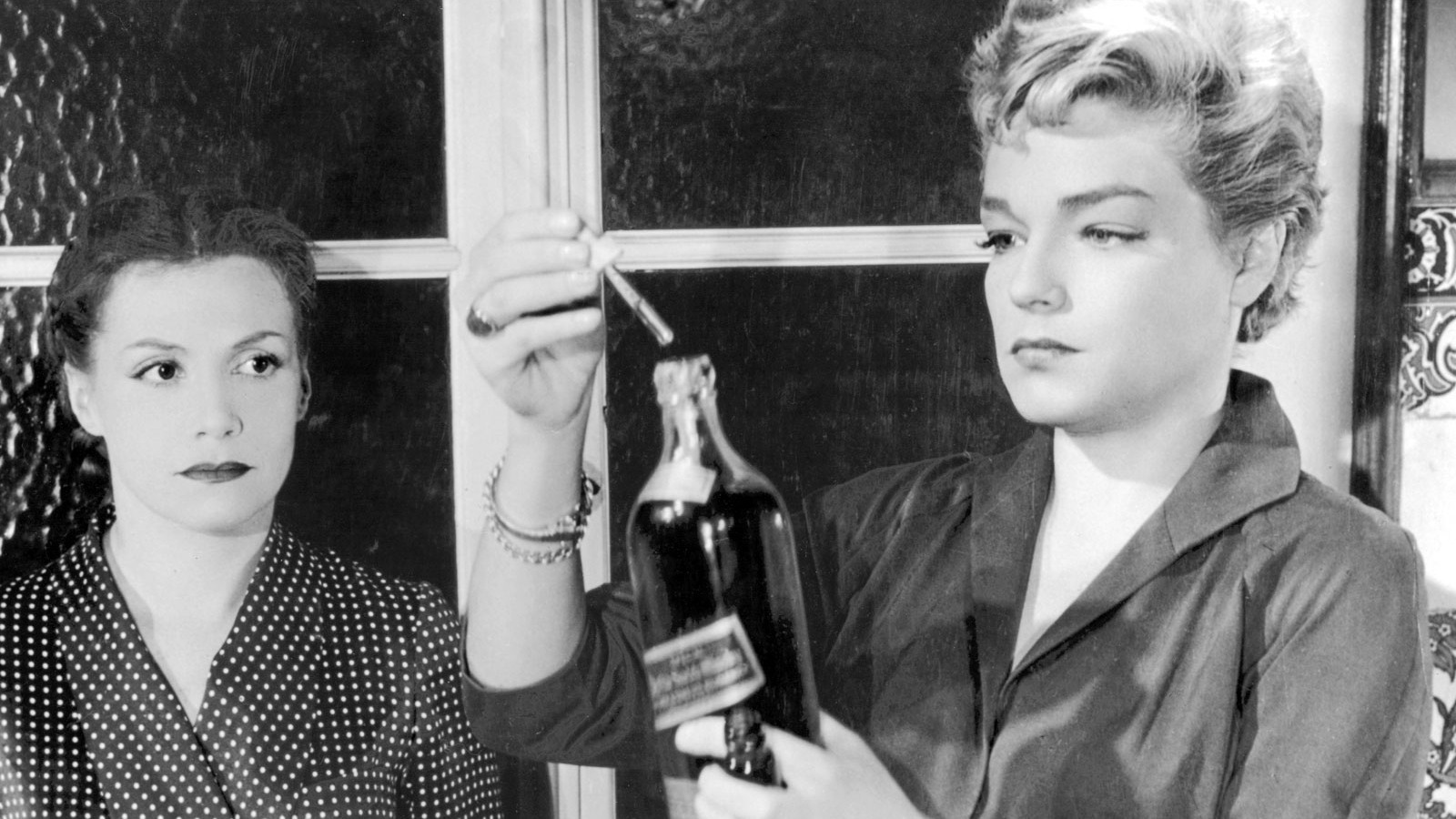
The other film Clouzot is justifiably famous for is “Diabolique”. There is a remake: skip it. Simone Signoret, and Vera Clouzot star as respectively the mistress and wife of a bully. The two women plot his murder. The film is based on a novel by Pierre Boilleau and Thomas Narcejac (aka Pierre Ayraud) called “Celle qui n’etait plus” (“She Was No More”). Paul Meurisse plays one of the most despicable characters in film history; a manipulative, sadistic bully, who truly cares for no one but himself. I promise there are no spoilers here. In fact, when you get to the end of the credits, there is a request that you not reveal any of the film’s secrets. And if the name of the actress playing the wife sounds familiar, they were married: The Clouzots.
A spooky little detail about this film: the wife character has a heart condition that impacts the plot. For instance, this condition makes her participation in the murder very difficult. 5 years after this film was released, Vera Clouzot died suddenly of a heart attack. She was also in “The Wages of Fear” and was possibly his muse. I don’t know if you can make the same case as with Karina and Goddard, but she seemed to bring the best out of him. Her death led to deep depression, and he had difficulty coping without her. He lived another 10 years, making films when he could bring himself to.
“Les Diaboliques” is a truly remarkable film, filled with unforgettable imagery, 3 electric performances, and some of Clouzot’s best direction. And before we leave this classic behind, there is one other little fact that links this film with Hitchcock. I mentioned at the beginning of this entry that this film was based on a novel written by Pierre Boilleau and Thomas Narcejac (aka Pierre Ayraud). This dynamic duo wrote another novel called “D’entre les morts (“From Among the Dead”). They wrote it specifically for Hitchcock. He took it, and turned it into a little movie you may have heard of: “Vertigo”.
7. From Russia With Love (1963)
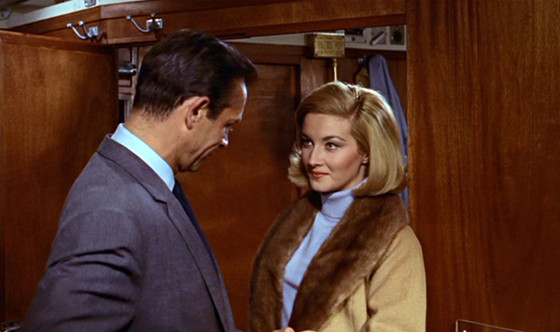
When I was a teenager, I believed James Bond was the polar opposite of Hitchcock. When I began to study film more closely, I realized I was right. However, there are a few exceptions. There are scenes scattered in several Bond films where Hitchcock comes to mind.
But, one film in the Bond canon can genuinely be seen as a homage to Hitchcock: “From Russia With Love”. How it comes to be a homage is rather complicated, and very interesting. Harry Saltzman and Albert “Cubby” Broccoli had wanted to turn Ian Fleming’s Bond novels into films since the mid-50’s. The novels were extremely popular in the UK, and virtually unknown in the US. In 1955, an American television film of the first Bond novel, “Casino Royale”, was broadcast on US TV. James Bond became American, and Felix Leiter became British. This fever dream had only one great attribute: Peter Lorre as Le Chiffre. In the twilight of his career, he is marvelously creepy.
When this film made little impression, Saltzman and Broccoli bought the rights, and kept trying to drum up interest in their ambition. They approached Hitchcock to direct “Dr. No”, and Cary Grant to star. Obviously, this happened in the wake of “North by Northwest’s” phenomenal success. They both refused, because neither of them wanted to be tied to a possible “franchise”. Then, the watershed moment happened: JFK’s interview in Time magazine. When asked what his 10 favorite books were, he listed 9 works of non-fiction: Politics, history, economics, philosophy, etc. And 1 work of fiction: “From Russia With Love”. The books flew off the shelves! Hollywood producers scrambled to get the film rights, but they were already owned by Saltzman and Broccoli.
So, onto the influences. Sean Connery always wore Cary Grant’s grey suit from “North by Northwest”. The director, Terrence Young, emphasized the assassin’s pursuit of Bond, as Bruno pursued Guy in “Strangers on a Train”. And if that wasn’t enough, “Russia” has a crop-duster scene. This was not in the novel. As Bond and Tatiana try to escape SPECTRE agents in a helicopter, they try to run him down, while dropping grenades on him. Instead of the plane crashing into an oil tanker truck, Bond assembles his rifle, shoots the pilot, who then drops a live grenade on the floor. Boom! Maybe it was the producers taking a dig at Hitchcock: “See what you missed out on?” And in a poignant piece of irony, this is the last film JFK lived to see.
8. The Bride Wore Black (1968)
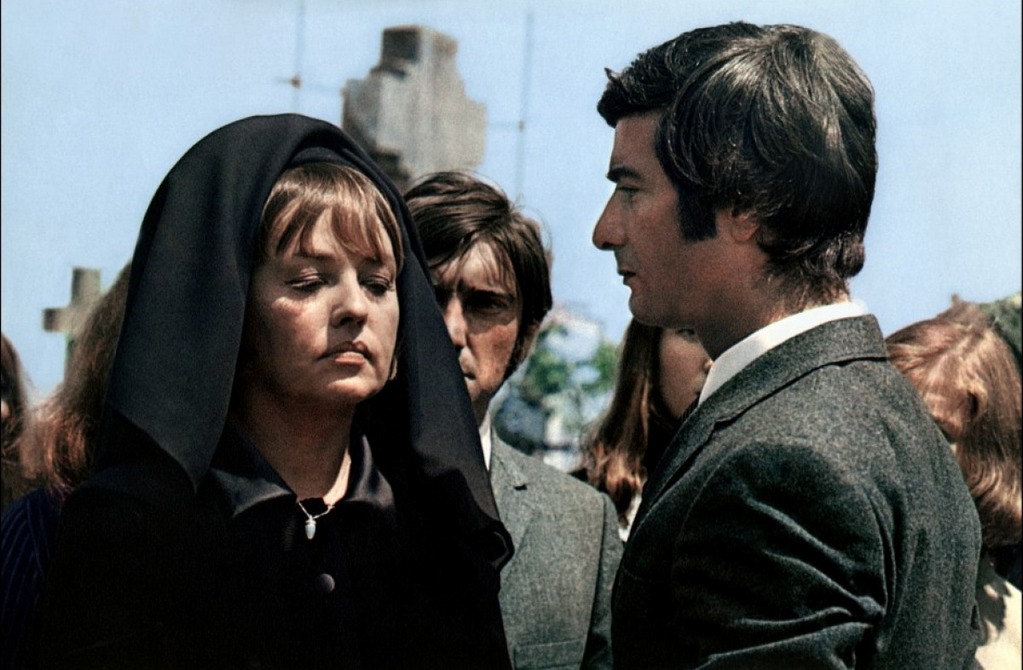
In 1968, the legendary critic Roger Ebert wrote the following about “The Bride Wore Black”: “Francois Truffaut’s ‘The Bride Wore Black’ is intended, he tells us, as homage to Alfred Hitchcock. As homage, it succeeds. As Hitchcock, it doesn’t quite. What a relief.” The great Jeanne Moreau stars as Julie Kohler, a mysterious woman who hunts down 5 men in order to murder them. If you are unfamiliar with this film, I will say no more about the plot. Other than the obvious (Truffaut’s claim) there are many elements in this film that support Truffaut’s tribute claim.
The film is based on the novel of the same name by William Irish. This is one of the pseudonyms used by Cornell Woolrich, who also wrote the short story “It Had to Be Murder”. That story is the basis for Hitchcock’s “Rear Window”. Where Truffaut succeeds in making a Hitchcock thriller involve the characters, and his direction.
Hitchcock seems to have 3 kinds of murder victims: “Innocents”, “those who deserve it”, and “bad people who want to atone”. The “Innocents” include the dog in “Rear Window”, the movie theater-goer in “Saboteur”, and the real Mr. Townsend in “North by Northwest”. Those who “deserve it” are characters who are usually a source of misery for the main characters: Miriam “In Strangers on a Train”, Willi in “Lifeboat”, and Sebastian in “Notorious”. These characters are not usually the villain, which means Sebastian is in a grey area. I consider the head Nazi’s who kill him the real villains. Because Sebastian chooses them, over his love for Alicia, he fits in that category. Those who want to atone include Janet Crane in “Psycho”, and Judy in “Vertigo”.
“The Bride Wore Black” features 2 of these kinds of victims. 4 of the victims all deserved it, and they are truly repulsive, chauvinistic jerks. There is one who “atones”: Fergus, the painter. Roger Ebert goes onto say that Fergus would never be a Hitchcock character, because his atonement is to declare his love for Julie. This makes her pause, and you can see her question whether this person needs to die.
As for Truffaut’s direction, I don’t remember any other Truffaut film with so many moving camera shots. Truffaut also has super-imposed, hallucinatory shots, during Coral’s death scene. Truffaut and Hitchcock were both experimental filmmakers, and it is moments like this, and several others, that link them together. And finally, this is the second, and last, collaboration between him and Bernard Herrman, who wrote many of Hitch’s greatest scores. They fell out over this film, and never worked together again. Regardless, this film is a worthy testament to 3 great artists.
9. Raise the Red Lantern (1991)
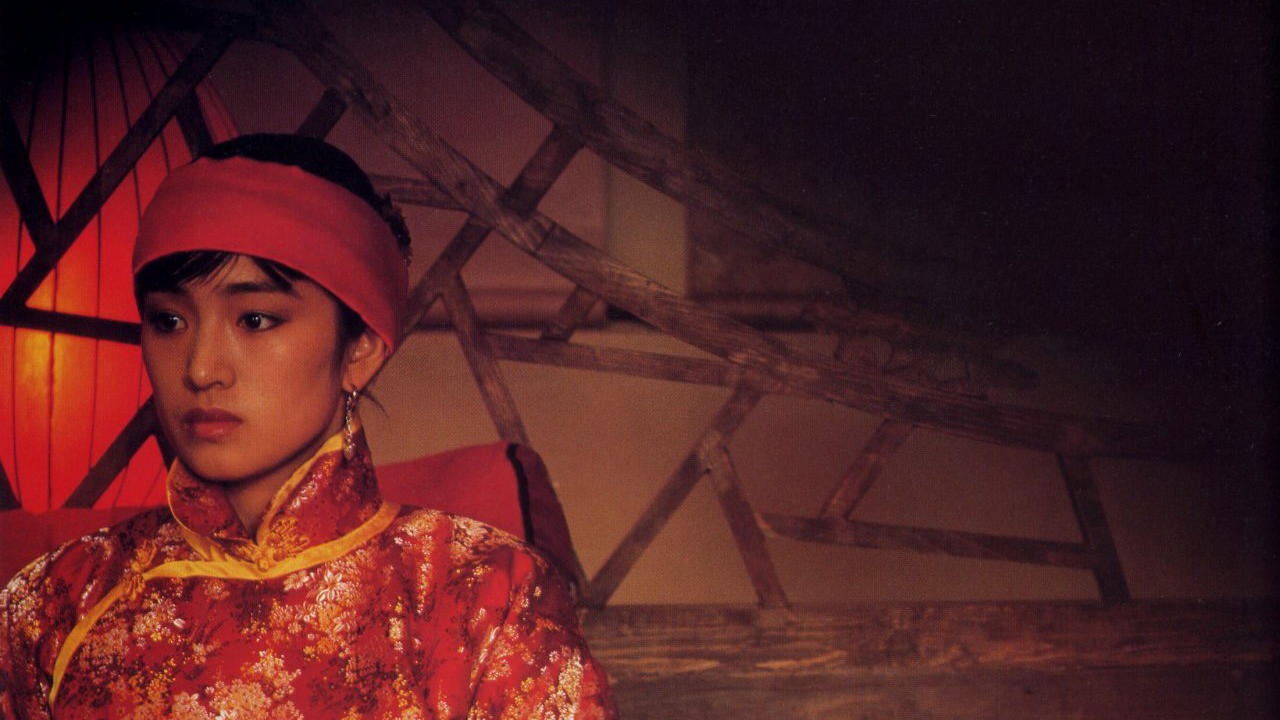
Zhang Yimou is the greatest living filmmaker I know of. Since his debut, “Red Sorghum” (1987), he has astonished the world with one great film after another. In my personal esteem, he shares an achievement that only one other filmmaker has earned. As far as I am concerned, Alfred Hitchcock made the best film of the 1950’s and the 1960’s: “Vertigo” (1958), and “Psycho” (1960). As far as I’m concerned, Zhang Yimou made the best film of the 1990’s and the 2000’s: “Raise the Red Lantern” (1991), and “Hero” (2002).
Zhang Yimou’s greatest film is “Raise the Red Lantern”. Adapted from the novel “Wives and Concubines” by Su Tong, we follow Songlian as she must abandon her college education to become a concubine for a wealthy man. Once we enter the man’s house, the camera never leaves. This entrapment in one place made me think of “Rebecca”. The second Mrs. DeWinter is tortured by Mrs. Danvers, trying to make the new wife mentally unhinged. The difference is, for all of the secrets Mr. DeWinter has, he is a fundamentally decent person, caught up in circumstance and confusion. At the end of “Rebecca”, Manderley is destroyed, allowing the two main characters to make a fresh start. In Songlian’s case, there is no escape.
The concubine system was unyielding, and inhuman. Being reduced to little more than animals, the women psychologically manipulate each other, in order to gain power in the household, or dignity. Songlian goes from a bright, perceptive young woman, into a vindictive, ruthless, and tragic figure. The fate of all of these women is to become their own Mrs. Danvers. Madness and death become the fate of most of the household. “The Haircut Scene” is directed as if Hitchcock were pulling Zhang Yimou’s strings. It is masterfully executed.
There are other scenes which evoke Hitchcock, and I have no doubt the Master is always in Zhang Yimou’s thoughts. This is a perfect film. However, the only DVD version available is in very poor condition. The image looks as if it has been run through a cheese grater. If you need subtitles, they seem to have been created by someone with brain damage. Honestly, I have never had to translate English before! One day, I hope this film will get the care, and attention, it deserves. See this film however you can. In whatever condition the print is in, it is one of the great works of art of the past 100 years.
10. Gone Girl (2014)
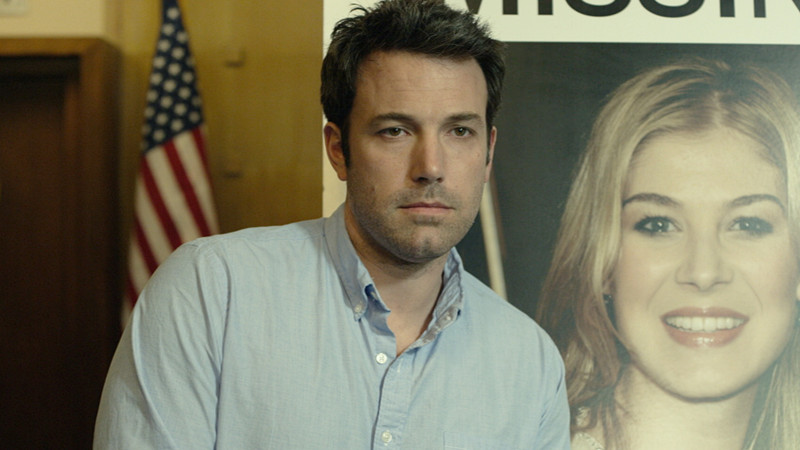
David Fincher is trying to make his case for being the new Hitchcock. With “Se7en”, and “Zodiac”, he is making some interesting films. “Gone Girl” is, for me, his most overt statement for being the heir to the throne. But, like his 2 other major thrillers, the final result is less Hitchcock, and more Fincher. I am happy with this, because no one will ever be Hitchcock. And we need new auteurs who will shape the future of film.
That being said, some of the Hitchcock references are overt, to the point of gushing. A character covered in blood takes a shower. The camera pans down, so we can watch the blood go down the drain: “Psycho”. A major plot twist in the middle of the film: “Vertigo”. The main character’s sister, who nags him enormously, almost as if she were his conscience: “Rear Window”. Did he kill his wife, or didn’t he: “Suspicion”. A woman falls asleep in her car, when a security officer shines a light in the car and says, “you can’t sleep here”: “Psycho”. And even the final solution of the film brings to mind “Marnie”. Where my doubt begins to show is there are as many references to film noir, and femme fatales as Hitchcock. Perhaps that is the best description of Fincher’s work: a Hitchcockian, film noir, with femme fatales.
“Gone Girl” is a highly absorbing, and disturbing, film. I don’t know if it confirms Fincher’s status as the next Master of Suspense, but it is definitely interesting, with a lot of loving nods to the Master.